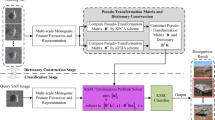Abstract
Synthetic aperture radar (SAR) automatic target recognition is an important application in SAR. How to extract features has restricted the application of SAR technology seriously. In this paper, a new feature extraction method for SAR automatic target recognition based on maximum interclass distance is proposed, which integrates class and neighborhood information. This method can reinforce discriminative power using maximum interclass distance, so it can improve recognition rate effectively.
Similar content being viewed by others
Referemces
Turk M, Pentland A P. Eigenface for recognition. J Neurosci, 1991, 3: 71–86
Belhumeur P N, Hespanaha P, Kriegman D J. Eigenface vs fisherfaces: Recognition using Class Specific Linear Projection. IEEE Trans Pattern Anal Mach Intell, 1997, 19: 711–720
Mishra A K, Mulgrew B. Bistatic SAR ATR using PCA-based features. Proc SPIE, 2006, 6234: 62340U–9
Mishra A K. Validation of PCA and LDA for SAR ATR. IEEE Region 10th Conference, 2008
Gunn S R. Support vector machines for classification and regression. Technical Report. Southampton: University of Southampton, 1998
Zhao Q, Principe J C. Support vector machines for SAR automatic target recognition. IEEE Trans Aerosp Electron Syst, 2001, 37(2): 643–654
Li Y, Lei X G, Bai B D, et al. Information compression and speckle reduction for multifrequency polarimetric SAR images based on kernel PCA. J Syst Eng Electron, 2008, 19(3): 493–498
Han P, Wu R B, Wang Y H, et al. An efficient SAR ATR approach. Proc IEEE International Conference on Acoustics, Speech and Signal Processing (ICASSP’03), Hongkong, 2003. 429–432
Lu H M, Fainman Y, Robert H N. Image manifolds. Proc SPIE, 1998, 3307: 52–63
Tenenbaum J B, Silva V D, Langford J C. A global geometric framework for nonlinear dimensionality reduction. Science, 2000, 290: 2319–2323
Belkin M, Niyogi P. Laplacian eigenmaps and spectral techniques for embedding and clustering. Adv Neural Inf Proc Syst, 2002, 14: 585–591
Roweis S T, Saul L K. Nonlinear dimensionality reduction by locally linear embedding. Science, 2000, 290: 2323–2326
He X F, Niyogi P. Locality preserving projections. Adv Neural Inf Proc Syst, 2004, 16: 153–160
Kokiopoulou E, Saad Y. Orthogonal neighborhood preserving projections: A projeciton-based dimensionality reduction technique. IEEE Trans Pattern Anal Mach Intell, 2007, 29(12): 2143–2156
Mishra A K, Mulgrew B. Bistatic SAR ATR. IET Radar Sonar and Navigation, 2007, 1: 459–469
Costa J A, HeroIII A O. Manifold learning using euclidean k-nearest neighbour graphs. IEEE International Conference on Acoustics, Speech and Signal Processing—Proceedings, Montreal, 2004, 3: 988–991
Yan S C, Xu D, Zhang B Y, et al. Graph embedding and extensions: A general framework for dimensionality reduction. IEEE Trans Pattern Anal Mach Intell, 2007, 29: 40–51
Fukunaga K. Introduction to Statistical Pattern Recognition. 2nd ed. Boston: Academic Press, 1990. 442–455
Ross T, Worrell S, Velten V, et al. Standard SAR ATR evaluation experiment using the MSTAR public release dataset. Int Soc Opt Eng, 1998, 3370: 566–573
Wang T, Huang Y L, Wu J J, et al. SAR ATR based on generalized principal component analysis integrating class information. IET International Radar Conference, Guilin, 2009
Cover T M. Estimation by the nearest neighbor rule. IEEE Trans Inform Theo, 1968, 14: 50–55
Author information
Authors and Affiliations
Corresponding author
Rights and permissions
About this article
Cite this article
Wang, B., Huang, Y., Yang, J. et al. A feature extraction method for synthetic aperture radar (SAR) automatic target recognition based on maximum interclass distance. Sci. China Technol. Sci. 54, 2520–2524 (2011). https://doi.org/10.1007/s11431-011-4430-0
Received:
Accepted:
Published:
Issue Date:
DOI: https://doi.org/10.1007/s11431-011-4430-0




